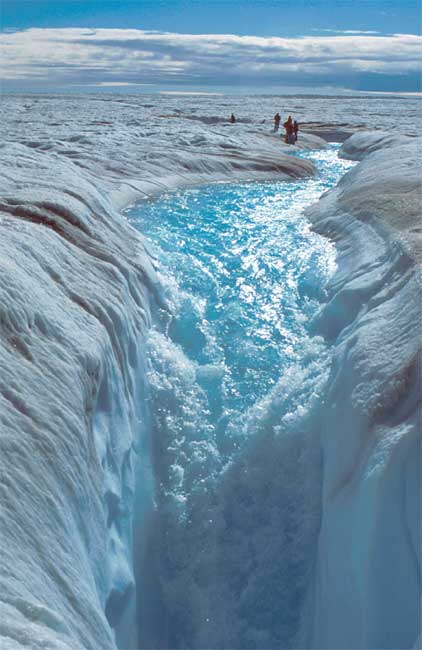
Greenland Ice Sheet Continues to Thin

SAN FRANCISCO — The disappearing Greenland Ice Sheet continues to thin along its edges, and could soon open up in the north, according to the latest results of satellite and aerial studies presented here today at the annual meeting of the American Geophysical Union.
The broad view is that the entire Greenland ice sheet is thinning, and has done so for 20 years, researchers reported at the meeting. But regionally, Greenland presents a more complicated story. Portions of the giant ice cap, one of the biggest blocks of ice on Earth, are melting faster than others, but a few places also seem to be getting thicker, scientists said.
Greenland's ice loss is accelerating by about 22 gigatons (22 cubic kilometers) of ice a year, said Beata Csatho, a professor at the University of Buffalo in New York. All of that melting ice adds to rising global sea levels, and future melting is expected to further contribute to that rise.
The north of the ice sheet in particular presents a possible future hazard should rapid thinning there continue. The northeast edge is thinning rapidly, with potential for opening up the rest of the northern portion of the ice to melt, Csatho said. The ice sheet could start flowing like a river out to the north if the edges thin rapidly enough.
The southeast part of the ice sheet is also melting at increasing rates, Csatho reported. The data comes from satellites and NASA's IceBridge campaign, which flies planes laden with instruments over both the Arctic and Antarctic to fill a gap between the retirement of one ice-monitoring satellite and the launch of another. [Dazzling Images from NASA's IceBridge]
While the southwest's famous Jakobshavn glacier seems stable, researchers at the University of Texas at Dallas found the Jakobshavn was rapidly thinning. The elevation change was 0.17 inches (4.34 millimeters) a year at the outlet glacier from IceBridge data, which covers the past four years, said doctoral student Wenlu Qi.
Laser altimetry data indicates that the entire ice sheet continues to thin even though snowfall over Greenland increased after the year 2000, said Bill Krabill, principal investigator for NASA's Airborne Topographic Mapper and a scientist at NASA's Wallops Flight Facility in Wallops Island, Va.
Sign up for the Live Science daily newsletter now
Get the world’s most fascinating discoveries delivered straight to your inbox.
"It's a consistent story. There are a few areas of thickening that are taking place, but anytime you get to the edge of Greenland, you are seeing thinning," he said.
Krabill, who works with NASA's IceBridge campaign, said the space agency just agreed to "re-wing" or replace the wings on the sturdy P-3 aircraft that flies for IceBridge. The IceBridge mission will "keep on to an extent" after the launch of ICESAT-2 for specific data collection and ICESat-2 data validation, NASA told OurAmazingPlanet in a tweet.Themodified P-3 flies daily missions through mid-May out of Thule and Kangerlussuaq, Greenland to measure sea and land ice.
Editor's note: This story was updated at 4:19 p.m. on Dec. 6, 2012, to correct the following error: The ice loss of Greenland is accelerating by 22 gigatons each year. That is not the total amount of ice lost each year.
This story was provided by OurAmazingPlanet, a sister site to LiveScience. Reach Becky Oskin at boskin@techmedianetwork.com. Follow her on Twitter @beckyoskin. Follow OurAmazingPlanet on Twitter @OAPlanet. We're also on Facebook and Google+.











